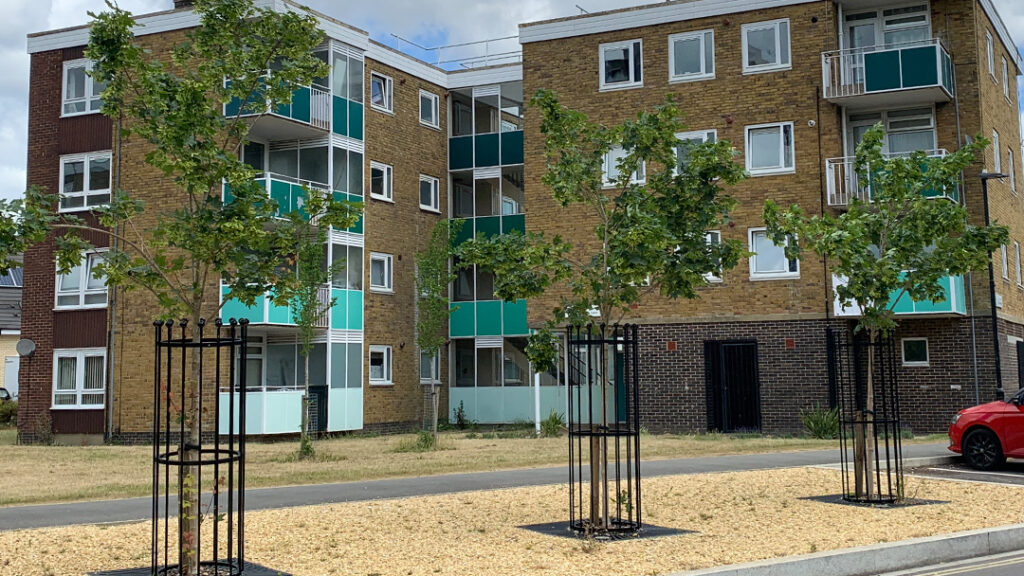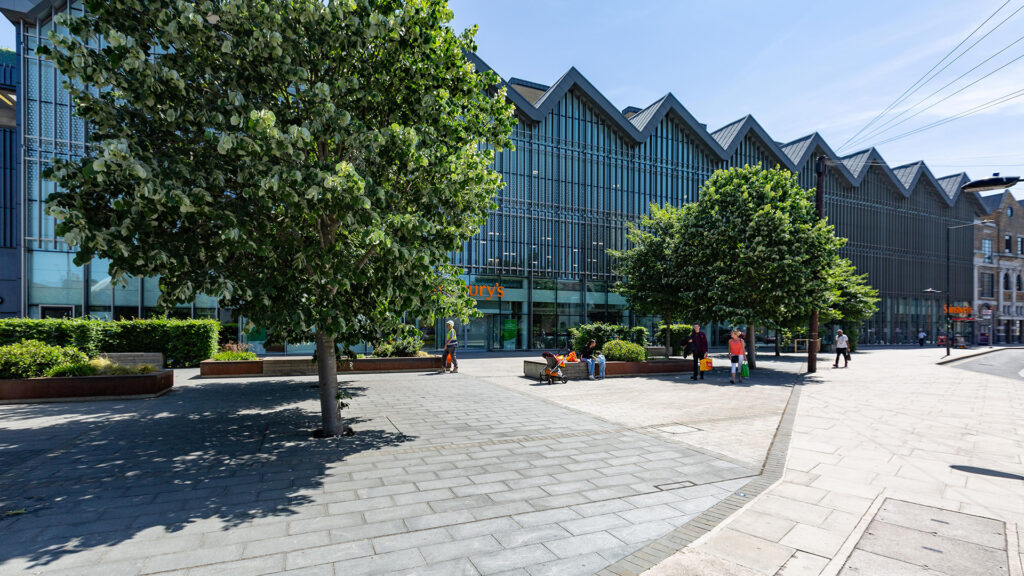The London Borough of Islington had invested a lot of time and treasure in their quest for solutions to the many sclerotizing problems inherent in the Archway Gyratory road layout at a critical point of the A1 route out of the City of London towards the North.
The London Borough of Islington had invested a lot of time and treasure in their quest for solutions to the many sclerotizing problems inherent in the Archway Gyratory road layout at a critical point of the A1 route out of the City of London towards the North.
It was probably already a bottleneck in the days of horse drawn traffic. The sounds, smells and pollution had changed, but not for the better. Safety had become precarious, especially for pedestrians and cyclists seeking to traverse through dense modern traffic patterns.
In 2014 consultation and project development was taken in-house by Transport for London with clearly defined objectives:-
- Reduce traffic dominance around the town centre
- Improve the accessibility of the junction for cyclists
- Improve safety and the perception of safety
- Provide a [New] high quality urban realm
- Protect the capacity of the A1
Project
Location
Contractor
Landscape Architect
The London Borough of Islington had invested a lot of time and treasure in their quest for solutions to the many sclerotizing problems inherent in the Archway Gyratory road layout at a critical point of the A1 route out of the City of London towards the North.
The London Borough of Islington had invested a lot of time and treasure in their quest for solutions to the many sclerotizing problems inherent in the Archway Gyratory road layout at a critical point of the A1 route out of the City of London towards the North.
It was probably already a bottleneck in the days of horse drawn traffic. The sounds, smells and pollution had changed, but not for the better. Safety had become precarious, especially for pedestrians and cyclists seeking to traverse through dense modern traffic patterns.
In 2014 consultation and project development was taken in-house by Transport for London with clearly defined objectives:-
- Reduce traffic dominance around the town centre
- Improve the accessibility of the junction for cyclists
- Improve safety and the perception of safety
- Provide a [New] high quality urban realm
- Protect the capacity of the A1
Project
Location
Contractor
Landscape Architect
Project
Location
Contractor
Landscape Architect
GreenBlue Urban have enabled Archway to maintain its greenery whilst also providing a great urban pedestrianized space. I would recommend GBU, their products help sustain the environment and are sleek and easy to install.
Connor Gavigan- Gavigan Paving
That fourth objective is a pure bonus for Londoners. Not just the alleviation of historic disadvantages but the creation of an environmentally attractive public open space amenity.
For the past twenty-five years GreenBlue Urban have also invested much time and treasure researching into what was causing the high mortality in urban tree planting and ways and products to re-create forest-floor-quality root space. In high traffic, arboriculturally alien, city-scapes this requires accurate control of irrigation, aeration, compaction avoidance and pollution control whilst, at the same time, ensuring service duct integrity and the protection of pedestrian and cycle access.
Assisting in the planning of this project was Katarzyna Bendowska, a Senior Planner at Islington Council, whilst Ringway Jacobs were the main contractor carrying out the install. GreenBlue Urban are delighted that Transport for London concluded, after evaluation, that the GBU ‘state of the art’ tree pit package deals incorporating RootSpace, RootDirectors, RootRain, Geonet, and soil (plus an additional 19 RootDirectors, Castle Tree Grilles and Thames Guards), though not the lowest in price, provided ‘the most reliable [package system] for healthy growth and reduced maintenance costs’
Having Archway Gyratory featured on the front cover of the recently launched London Mayor Strategy 2017, Grayham Tindal, Transport for London arboriculturist, writes: – ‘TfL are continuing to improve the environment for the health and wellbeing of our customers. Planting trees in the streets of London has many challenges, in this instance these were solved using a cellular system. We have found GBU very supportive and their products delivered all the requirements and expectations for this project. I am sure TfL will be working with GBU again in the future.’
GreenBlue Urban have enabled Archway to maintain its greenery whilst also providing a great urban pedestrianized space. I would recommend GBU, their products help sustain the environment and are sleek and easy to install.
Connor Gavigan- Gavigan Paving
That fourth objective is a pure bonus for Londoners. Not just the alleviation of historic disadvantages but the creation of an environmentally attractive public open space amenity.
For the past twenty-five years GreenBlue Urban have also invested much time and treasure researching into what was causing the high mortality in urban tree planting and ways and products to re-create forest-floor-quality root space. In high traffic, arboriculturally alien, city-scapes this requires accurate control of irrigation, aeration, compaction avoidance and pollution control whilst, at the same time, ensuring service duct integrity and the protection of pedestrian and cycle access.
Assisting in the planning of this project was Katarzyna Bendowska, a Senior Planner at Islington Council, whilst Ringway Jacobs were the main contractor carrying out the install. GreenBlue Urban are delighted that Transport for London concluded, after evaluation, that the GBU ‘state of the art’ tree pit package deals incorporating RootSpace, RootDirectors, RootRain, Geonet, and soil (plus an additional 19 RootDirectors, Castle Tree Grilles and Thames Guards), though not the lowest in price, provided ‘the most reliable [package system] for healthy growth and reduced maintenance costs’
Having Archway Gyratory featured on the front cover of the recently launched London Mayor Strategy 2017, Grayham Tindal, Transport for London arboriculturist, writes: – ‘TfL are continuing to improve the environment for the health and wellbeing of our customers. Planting trees in the streets of London has many challenges, in this instance these were solved using a cellular system. We have found GBU very supportive and their products delivered all the requirements and expectations for this project. I am sure TfL will be working with GBU again in the future.’
The ‘value added’ benefits of the project as defined by TfL include:-
- Openness in the centre of the square creating sunny areas for outdoor Seating
- Flexible square with space suitable for a range of events, activities and a Market
- Protection from wind and screened from surrounding roads by trees planted along its fringes
- A clearly demarcated cycle track
- Consistency of paving materials throughout the square, including privately owned parts of the square
- Street furniture reflecting the history and heritage
GreenBlue Urban are proud of their company Core Values, their technical and sales support teams are always interested to hear about project challenges from architect and landscape professionals. CPDs and bespoke consultations are freely available. Urban regeneration is a fast-moving discipline and GBU rely on ‘market soundings’ to help them in their on-going R & D progress.
Working closely with Contractors and Sub Contractors; Connor Gavigan of Gavigan Paving states “Radical changes at the A1 Archway Gyratory will reduce the impact of traffic and make the area feel cleaner and greener. We have removed the roundabout to create a peninsular, to improve the safety for vehicles, cyclists & pedestrians. The widened footpaths and new crossing points will help improve the flow of foot traffic, whilst maintaining the flow of vehicle traffic”.
“GreenBlue Urban have enabled Archway to maintain its greenery whilst also providing a great urban pedestrianized space. I would recommend GBU, their products help sustain the environment are sleek and easy to install!.
Discover our latest panoramic installation video here!
The ‘value added’ benefits of the project as defined by TfL include:-
- Openness in the centre of the square creating sunny areas for outdoor Seating
- Flexible square with space suitable for a range of events, activities and a Market
- Protection from wind and screened from surrounding roads by trees planted along its fringes
- A clearly demarcated cycle track
- Consistency of paving materials throughout the square, including privately owned parts of the square
- Street furniture reflecting the history and heritage
GreenBlue Urban are proud of their company Core Values, their technical and sales support teams are always interested to hear about project challenges from architect and landscape professionals. CPDs and bespoke consultations are freely available. Urban regeneration is a fast-moving discipline and GBU rely on ‘market soundings’ to help them in their on-going R & D progress.
Working closely with Contractors and Sub Contractors; Connor Gavigan of Gavigan Paving states “Radical changes at the A1 Archway Gyratory will reduce the impact of traffic and make the area feel cleaner and greener. We have removed the roundabout to create a peninsular, to improve the safety for vehicles, cyclists & pedestrians. The widened footpaths and new crossing points will help improve the flow of foot traffic, whilst maintaining the flow of vehicle traffic”.
“GreenBlue Urban have enabled Archway to maintain its greenery whilst also providing a great urban pedestrianized space. I would recommend GBU, their products help sustain the environment are sleek and easy to install!.
Discover our latest panoramic installation video here!







